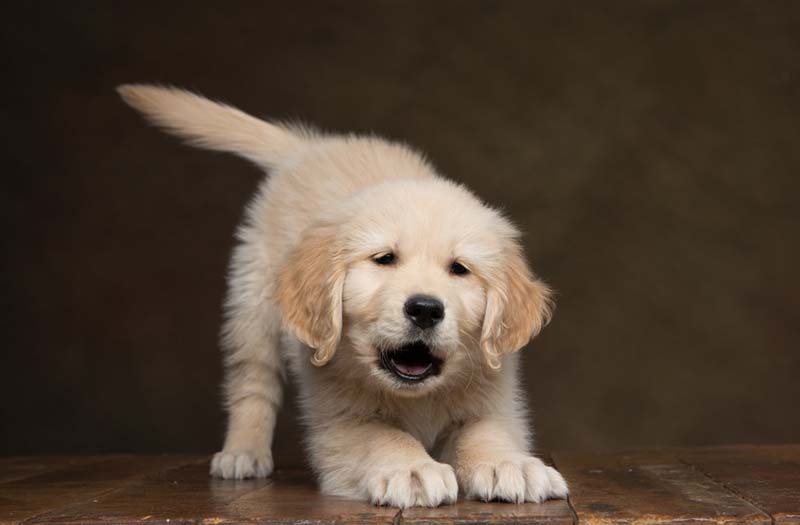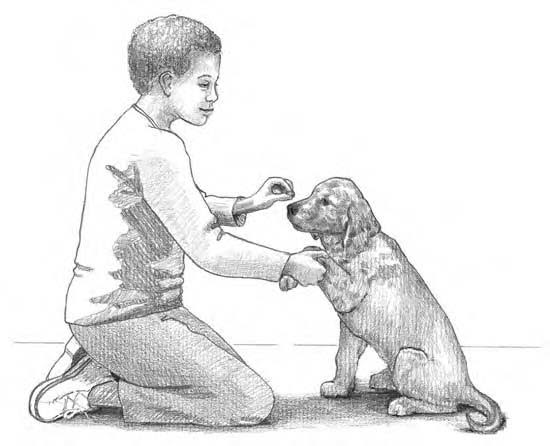In This Chapter
Tricks are a real delight and can be fun for your pup to learn if you have the right approach: Training doesn’t have to be all work and structure. After your puppy knows the basic directions and shows that he enjoys the process of learning, teaching a trick or two spices up the normal routine. This chapter gives you ten favorite tricks that the two of you can learn together. You don’t have to teach every trick — just those your pup picks up easily. For example, if your puppy is paw expressive, he’ll definitely get into the Paw or Wave tricks.
Warning!
Never practice tricks during lesson time. Otherwise, you turn serious work into a game.
Bow
1. As your puppy’s stretching, bow toward him and say “Bow!”
2. Praise your puppy like he just invented the puppy biscuit.
Paw
1. Say “Paw” or “Shake” as you extend a treat in front of his nose with one hand and extend the other in front of your puppy’s leg.
2. If he looks puzzled, press his shoulder muscle with your other hand.
3. Take his paw the instant he lifts it off the ground and praise him (see Figure 22-1).
Soon he’ll be reaching out for you.
Tip
A puppy can learn many tricks from one action. With pawing, for example, you can teach your puppy to shake your hand, wave a big hello, or give you a high-five.
Wave
1. Have your puppy sit. Hold a treat inches from his nose and say “Wave” as you wave your hand in front of him.
2. Praise and treat him the instant he lifts his paw.
3. Encourage more enthusiastic waving as he catches on.
Tip
If your puppy is conditioned to cooperate when given a treat, phase out the treats gradually. However, always praise enthusiastically!
High-Five
1. Do two Paw exercises. Be enthusiastic.
2. Hold your hand up and out for the High-Five. Say “Paw, high-five!”
3. Lower your hand if your puppy makes an attempt.
Soon, he’ll be bringing that paw up with gusto.
Roll Over
1. Get a handful of treats and encourage your puppy into a “Down” position.
2. Scratch him until he rolls to one side.
3. Take the treat and circle it from your puppy’s nose, under his chin, and around behind his ear over the back of his neck (see Figure 22-2a).
4. Say “Roll Over” as you circle the treat around his nose toward the opposite side of the floor (see Figure 22-2b).
Tip
Imagine a string tied from the treat to your puppy’s nose. Basically, you’re trying to pull his body over.
5. If he seems to lean into it, praise him, and flip his paws over.
When he’s rolled over, treat and praise him (see Figure 22-2c) and encourage him to jump up.
Over
Warning!
Puppies younger than a year should not jump at heights above their elbows – too much development is going on under the skin. Forcing high jumps could cause serious developmental damage.
1. Place your puppy on-lead for control.
2. Let him sniff the jump, and show him a couple of times how you jump the obstacle.
Discourage any chewing with a leash tug.
3. Give your puppy at least five strides of runway space and say “Over” as you trot toward the jump. Jump ahead of your puppy and cheer him for following you.
Remember
If your puppy refuses to jump, stay calm. Don’t pull him over. Walk over the jump several times while your puppy watches. Then try to walk over it together. Although it may take a few tries, your puppy will soon overcome his fear and be more excited for succeeding.
4. After your puppy takes the jump with pride, put him on a short lead. Drop the lead just before the jump to let your puppy take it alone.
Bravo. Enthusiastically praise your pooch.
5. Slowly fade out your approaching run but keep saying “Over” as you point to the jump.
Just for fun
“Over” can also be a game for the kids. Jumps placed in thresholds encourage jumping to fetch toys and balls. The kids can set up a course, inside or out, and jump with the puppy.
Through the Hoop
1. Set up your original jumping pole across a threshold or between two pieces of furniture.
2. Ask someone to hold the hoop or prop it up securely.
3. Instruct your puppy “Over” as you run toward the hoop, letting go of the lead as you get close (see Figure 22-3b).
4. After your puppy cooperates, combine the “Through” and “Over” directions as you start for the jump, like this: “Over-Through.”
5. Hold the hoop higher so that it’s even with the height of the original jumping pole and say “Over-Through” (see Figure 22-3c).
Your puppy may hesitate because the hoop looks, well, like a hoop, not like a level jump. If he hesitates, walk over to the hoop slowly and allow him to walk through it a couple of times. Use food to encourage him.
After he successfully completes Step 5, you’re ready for the solo hoop.
6. Prop the hoop at floor level, encourage “Through” as you trot toward the hoop, and allow your puppy to go through alone.
Praise him and encourage him back through by running backward as you cheer.
7. Gradually raise the level of the hoop.
Tip
If you want to be really clever (and you have a puppy who won’t grow too big!), you can practice Through the Hoop with your encircled arms. Repeat the preceding steps with the assistance of a close friend, this time using your arms in place of the hoop.
Ask Nicely
Remember
Good balance is a requirement for the Ask Nicely trick. You’re asking your puppy to tilt back from a sitting position and balance on his hind paws, like the old begging routine. (Unless your puppy is a natural, wait until your puppy is 9 months old before you teach this routine. You don’t want to put undo pressure on developing muscles and tissues.) Follow these steps to teach the Ask Nicely trick:
1. Break up five of your pup’s favorite treats.
2. With your pup in a sitting position, place a treat a few centimeters above his nose.
3. Direct “Ask Nicely” as you bring the treat back toward his ears.
If he tilts back for a split second, treat and praise him. Encourage the slightest effort initially, and then slowly increase your expectations.
Tip
For complicated tricks like this one, praise each step toward the goal. If at first your puppy tries to lean back, praise that. After leaning back becomes a snap, praise the next step your puppy attempts, such as lifting his paws off the ground.
Play Dead
1. Direct “Down.” Encourage your puppy to rest on one side.
2. Kneel next to your pup, but don’t look at him. Then tap the floor near his head and say “Play Dead,” “Nap Time,” “Chill,” or “Bang.”
3. Gently apply pressure to his shoulder and help him rest his head on the floor.
4. Keep his head in place by stroking it gently while saying “Stay.”
Speak and Shhh!
1. Organize this situation, and as he’s getting stimulated (see Figure 22-4a), get excited with him as you flash a snappy signal and say “Speak” (see Figure 22-4b).
2. Praise him for cooperating — even bark with him, especially if he seems confused.
3. Initially break his concentration with a toy, treat, or praise.
1. Encourage him to bark. Praise him and bark along — make it a good old time.
2. Suddenly, stand tall and say “Shhh” as you wave your arm diagonally across your body up to your mouth (see Figure 22-4c).
He’s likely to be taken by surprise — and may step back too.
3. The instant he stops barking, treat him (preceding the food with a clicker if you’re using one) and praise him well.
Tip
You may also use a treat cup to encourage him to follow you simply by shaking the cup and running away from him the moment he quiets. This method is especially useful if your goal is to have him bark when people come or if he hears a noise.










